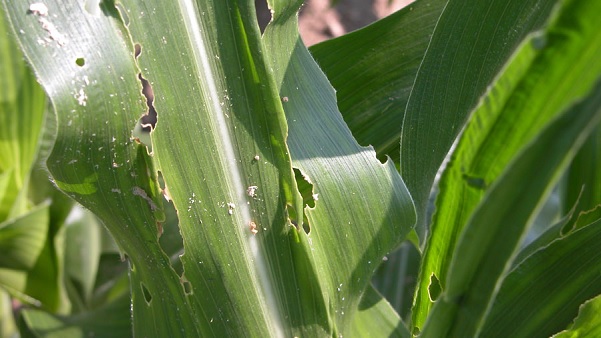
In collaboration with the Food and Agriculture Organization of the United Nations (FAO) and other development partners, the Government of Ethiopia has intensified efforts to protect major maize growing areas from the ravage of the fall armyworm.
The fall armyworm, which first arrived in Africa in 2016, was intercepted on a few hectares of irrigated maize fields in southern Ethiopia in the last week of February 2017. It has now covered about 52 962 hectares in 144 districts in three of the major maize-growing regional states – Gambella, Oromia and Southern Nations Nationalities and Peoples’ Region (SNNPR).
Tazelekew Habtamu, a maize farmer in southern Ethiopia where the insect set foot for the first time in Ethiopia, observed unusual insect pest infestation on his maize farm in the first week of March 2017. He reported the case to a local agriculture extension worker, who facilitated immediate pesticide spraying. “At first, the fall armyworm infestation was huge,” said Tazelekew. “The pesticide spray killed most of the pests. I would have lost my maize plants if I did not use the pesticide. However, some remnants of the fall armyworm are still attacking my maize field.”
The fall armyworm is a migratory insect pest known to cause massive destruction of maize crops under warm and humid conditions in the Americans. In Ethiopia, maize fields planted in belg and meher seasons in the prevailing warm and moist weather conditions provide favorable environment for the insect to multiply massively and spread to more areas.
“The weather conditions from March to September in maize growing areas provide fertile ground for the insect to mass multiply and spread easily,” said Zebdewos Salato, Director of the Plant Protection Directorate at the Ethiopian Ministry of Agriculture and Natural Resources. Aided by wind front, the fall armyworm of a single generation can spread quickly as far as 500 km away from its point of emergence.
“We expect the infestation to spread to other regions and cover wider areas in the coming months,” he said. “Many farmers in the regions have already planted maize or will plant in June. As more areas plant maize it is very likely that the pests will spread to more maize areas including in Afar, Amhara, Benishangul Gumz, Oromia and Tigray. We are working hard to make vulnerable regions aware of the need to prepare for possible fall armyworm infestation.”
“The insect is establishing itself and is expected to remain an economic pest for very long time to come hence we need to put in place a short and long term fall armyworm management and control plan,” said Bayeh Mulatu, National Integrated Pest Management Expert at FAO Ethiopia.
Read the complete story at FAO
——
See also:
